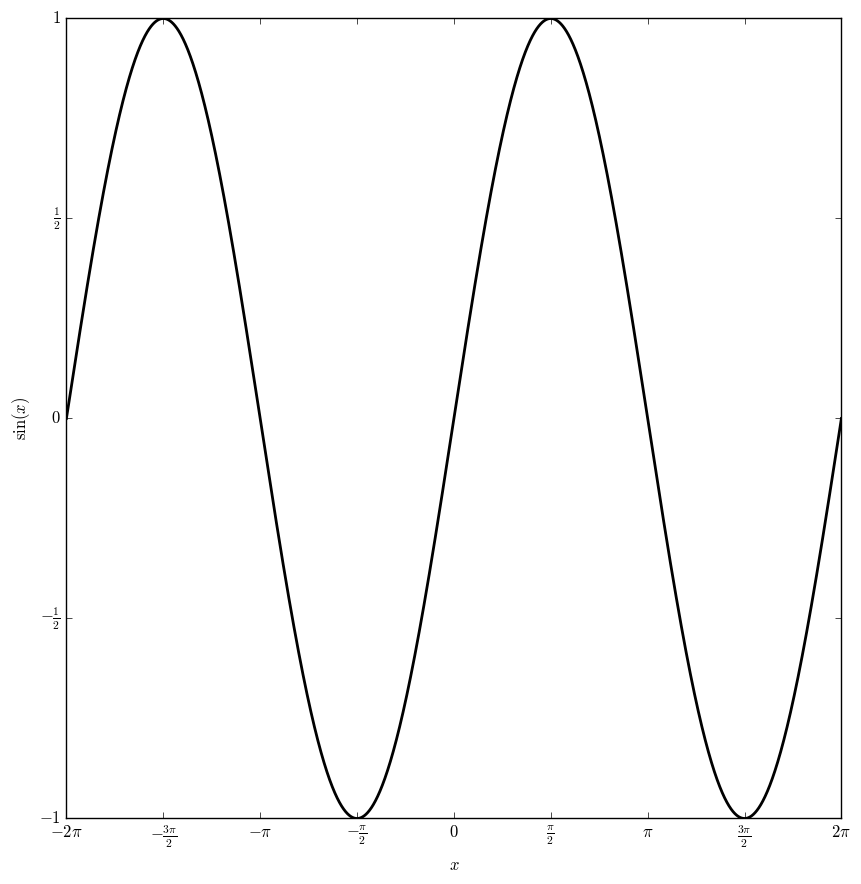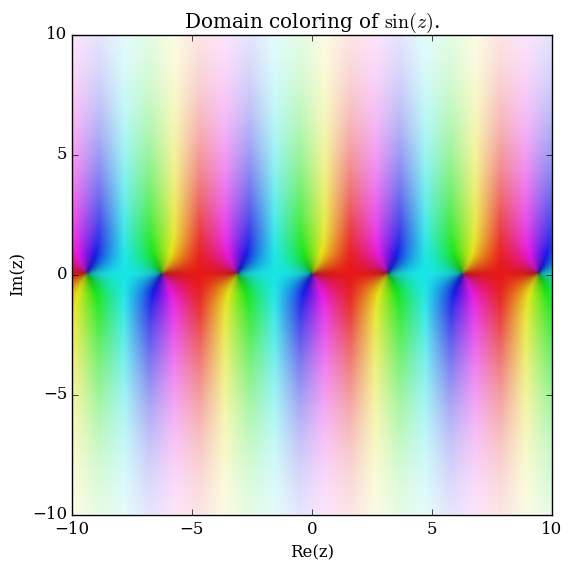Difference between revisions of "Sine"
| Line 37: | Line 37: | ||
<center>{{:Trigonometric functions footer}}</center> | <center>{{:Trigonometric functions footer}}</center> | ||
| + | |||
| + | [[Category:SpecialFunction]] | ||
Revision as of 18:44, 24 May 2016
The sine function $\sin \colon \mathbb{C} \rightarrow \mathbb{C}$ is defined by $$\sin(z)=\dfrac{e^{iz}-e^{-iz}}{2i},$$ where $e^z$ is the exponential function.
Domain coloring of $\sin$.
Contents
- 1 Properties
- 1.1 Theorem
- 1.2 Proof
- 1.3 References
- 1.4 Theorem
- 1.5 Proof
- 1.6 References
- 1.7 Theorem
- 1.8 Proof
- 1.9 References
- 1.10 Theorem
- 1.11 Proof
- 1.12 References
- 1.13 Theorem
- 1.14 Proof
- 1.15 References
- 1.16 Theorem
- 1.17 Proof
- 1.18 References
- 1.19 Theorem
- 1.20 Proof
- 1.21 References
- 1.22 Theorem
- 1.23 Proof
- 1.24 References
- 1.25 Theorem
- 1.26 Proof
- 1.27 References
- 1.28 Theorem
- 1.29 Proof
- 1.30 References
- 1.31 Theorem
- 1.32 Proof
- 1.33 References
- 2 See Also
- 3 Videos
- 4 References
Properties
Theorem
The following formula holds: $$\dfrac{\mathrm{d}}{\mathrm{d}z} \sin(z) = \cos(z),$$ where $\sin$ denotes the sine function and $\cos$ denotes the cosine function.
Proof
From the definition, $$\sin(z) = \dfrac{e^{iz}-e^{-iz}}{2i},$$ and so using the derivative of the exponential function, the linear property of the derivative, the chain rule, and the definition of the cosine function, $$\begin{array}{ll} \dfrac{\mathrm{d}}{\mathrm{d}z} \sin(z) &= \dfrac{1}{2i} \left[ \dfrac{\mathrm{d}}{\mathrm{d}z} [e^{iz}] - \dfrac{\mathrm{d}}{\mathrm{d}z}[e^{-iz}] \right] \\ &= \dfrac{1}{2i} \left[ ie^{iz} + ie^{-iz} \right] \\ &= \dfrac{e^{iz}+e^{-iz}}{2} \\ &= \cos(z), \end{array}$$ as was to be shown. █
References
- 1964: Milton Abramowitz and Irene A. Stegun: Handbook of mathematical functions ... (previous) ... (next): $4.3.105$
Theorem
The following formula holds for all $z \in \mathbb{C}$: $$\sin^2(z)+\cos^2(z)=1,$$ where $\sin$ denotes the sine function and $\cos$ denotes the cosine function.
Proof
From the definitions $$\sin(z)=\dfrac{e^{iz}-e^{-iz}}{2i}$$ and $$\cos(z)=\dfrac{e^{iz}+e^{-iz}}{2},$$ using the square of i in the denominator of the first term, we see $$\begin{array}{ll} \sin^2(z)+\cos^2(z)&=\left( \dfrac{e^{iz}-e^{-iz}}{2i} \right)^2 + \left( \dfrac{e^{iz}+e^{-iz}}{2} \right)^2 \\ &= -\dfrac{1}{4} (e^{2iz}-2+e^{-2iz})+ \dfrac{1}{4} (e^{2iz}+2+e^{-2iz}) \\ &= 1, \end{array}$$ as was to be shown. █
References
Theorem
Let $z_0 \in \mathbb{C}$. The following Taylor series holds: $$\sin(z)=\displaystyle\sum_{k=0}^{\infty} \dfrac{(-1)^k z^{2k+1}}{(2k+1)!},$$ where $\sin$ denotes the sine function.
Proof
Using the Taylor series of the exponential function and the definition of $\sin$, $$\begin{array}{ll} \sin(z) &= \dfrac{e^{iz}-e^{-iz}}{2i} \\ &= \dfrac{1}{2i} \left[ \displaystyle\sum_{k=0}^{\infty} \dfrac{i^k (z-z_0)^k}{k!} - \displaystyle\sum_{k=0}^{\infty} \dfrac{(-1)^k i^k (z-z_0)^k}{k!} \right] \\ &= \dfrac{1}{2i} \displaystyle\sum_{k=0}^{\infty} \dfrac{(z-z_0)^k}{k!}i^k (1-(-1)^k). \end{array}$$ Note that if $k=2n$ is a positive even integer, then $$i^k(1-(-1)^k)=i^{2n}(1-(-1)^{2n})=0,$$ and if $k=2n+1$ is a positive odd integer, then $$i^k(1-(-1)^k)=i^{2n+1}(1-(-1)^{2n+1})=2i(-1)^n.$$ Hence we have derived $$\begin{array}{ll} \sin(z)&=\dfrac{1}{2i} \displaystyle\sum_{k=0}^{\infty} \dfrac{(z-z_0)^k}{k!}i^k (1-(-1)^k) \\ &=\displaystyle\sum_{k \mathrm{\hspace{2pt} odd},k>0}^{\infty} \dfrac{(z-z_0)^k}{k!}i^k (1-(-1)^k) \\ &= \displaystyle\sum_{k=0}^{\infty} \dfrac{(-1)^k (z-z_0)^{2k+1}}{(2k+1)!}, \end{array}$$ as was to be shown. █
References
Theorem
The following formula holds: $$\sin(z) = z \displaystyle\prod_{k=1}^{\infty} \left( 1 - \dfrac{z^2}{k^2\pi^2} \right),$$ where $\sin$ denotes the sine function and $\pi$ denotes pi.
Proof
References
- REDIRECT Gamma(z)Gamma(1-z)=pi/sin(pi z)
Theorem
The following formula holds: $$B(x,y)=2 \displaystyle\int_0^{\frac{\pi}{2}} (\sin t)^{2x-1}(\cos t)^{2y-1} \mathrm{d}t,$$ where $B$ denotes the beta function, $\sin$ denotes the sine function, and $\cos$ denotes the cosine function.
Proof
From the definition, $$B(x,y)=\displaystyle\int_0^1 \xi^{x-1} (1-\xi)^{y-1} \mathrm{d}\xi.$$ Let $\xi=\sin^2(t)$. Then $d\xi = 2\sin(t)\cos(t)$. Also if $\xi=0$ then $0=\sin^2(t)$ implies that $t=\arcsin(0)=0$ and if $\xi=1$, then $1=\sin^2(t)$ implies $t=\arcsin(1)=\dfrac{\pi}{2}$. Therefore using substitution and the Pythagorean identity for sin and cos, $$\begin{array}{ll} B(x,y) &= \displaystyle\int_0^1 \xi^{x-1}(1-\xi)^{y-1} \mathrm{d}\xi \\ &= \displaystyle\int_0^{\frac{\pi}{2}} (\sin(t))^{2x-2} (1-\sin^2(t))^{y-1} 2 \sin(t)\cos(t) \mathrm{d}t \\ &= 2 \displaystyle\int_0^{\frac{\pi}{2}} (\sin(t))^{2x-1} (\cos(t))^{2y-1} \mathrm{d}t, \end{array}$$ as was to be shown. █
References
- 1953: Arthur Erdélyi, Wilhelm Magnus, Fritz Oberhettinger and Francesco G. Tricomi: Higher Transcendental Functions Volume I ... (previous) ... (next): $\S 1.5 (19)$
- 1964: Milton Abramowitz and Irene A. Stegun: Handbook of mathematical functions ... (previous) ... (next): $6.2.1$
Theorem
The following formula holds: $$\sin(az)=az{}_0F_1 \left(;\dfrac{3}{2};-\dfrac{(az)^2}{4} \right),$$ where $\sin$ denotes the sine function and ${}_0F_1$ denotes the hypergeometric pFq.
Proof
References
Theorem
The following formula holds for non-negative integers $n$: $$j_n(z)=(-1)^nz^n \left( \dfrac{1}{z} \dfrac{\mathrm{d}}{\mathrm{d}z} \right)^n \left( \dfrac{\sin z}{z} \right),$$ where $j_n$ denotes the spherical Bessel function of the first kind and $\sin$ denotes the sine function.
Proof
References
Theorem
The following formula holds: $$\sin(z)=-i \sinh(iz),$$ where $\sin$ denotes the sine and $\sinh$ denotes the hyperbolic sine.
Proof
From the definition of $\sin$ and $\sinh$ and the reciprocal of i, $$-i\sinh(iz) = \dfrac{e^{iz}-e^{-iz}}{2i} =\sin(z),$$ as was to be shown.
References
Theorem
The following formula holds: $$\sinh(z)=-i\sin(iz),$$ where $\sinh$ is the hyperbolic sine and $\sin$ is the sine.
Proof
By definition, $$\sinh(z) = \dfrac{e^{z}-e^{-z}}{2},$$ and so by the definition of $\sin$ and the reciprocal of i, we see $$-i\sinh(iz)=\dfrac{e^{iz}-e^{-iz}}{2i},$$ as was to be shown. █
References
- 1964: Milton Abramowitz and Irene A. Stegun: Handbook of mathematical functions ... (previous) ... (next): $4.5.7$
Theorem
The following formula holds: $$\sin(\mathrm{gd}(x))=\tanh(x),$$ where $\sin$ denotes the sine, $\mathrm{gd}$ denotes the Gudermannian, and $\tanh$ denotes the hyperbolic tangent.
Proof
References
Theorem
The following formula holds: $$\mathrm{tanh}(\mathrm{gd}^{-1}(x))=\sin(x),$$ where $\mathrm{tanh}$ denotes the hyperbolic tangent, $\mathrm{gd}^{-1}$ denotes the inverse Gudermannian, and $\sin$ denotes sine.
Proof
References
See Also
Videos
References
The sine product formula and the gamma function

